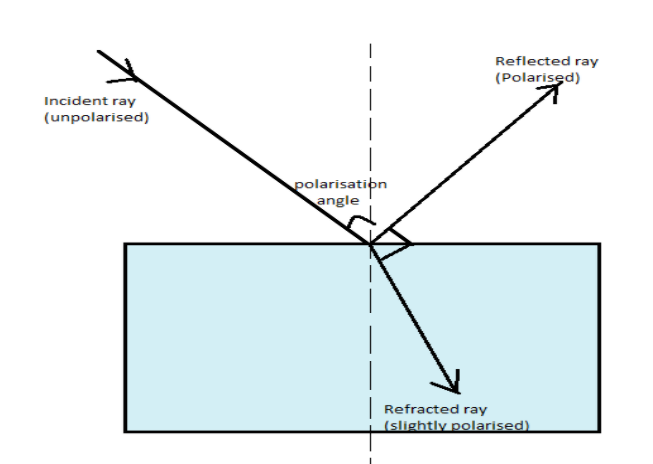
What is meant by polarization angle ? Find angle between reflected and refracted rays whenever light rays incident on polarization angle. Draw a suitable ray diagram.
Answer
563.4k+ views
Hint: Polarization angle is an angle of incidence at which light with a particular polarization is perfectly transmitted through a transparent dielectric surface, with no reflection.
Complete step by step solution:
The phenomenon of light being polarized by reflection from a surface at a particular angle was first observed by Louis Malus in 1808.
Malus attempted to relate the polarizing angle to the refractive index of the material, but was frustrated with the quality of glasses available at that time.
In 1815, Brewster experimented with higher – quality materials and showed that this angle was a function of the refractive index, and thus given Brewster’s law. Thus polarization angle is also known as Brewster’s angle.
Polarization angle is an angle of incidence at which light with a particular polarization is perfectly transmitted through a transparent dielectric surface, with no reflection.
When unpolarized light is incident at this angle, the light that is reflected from the surface is therefore perfectly polarized.

When light encounters a boundary between two media with different refractive indices, some of it is usually reflected as shown in figure.
The fraction that is reflected and the fraction that is refracted have a relation such that the angle between them is \[{90^\circ }\].
Note: Polarization angle is also known as Brewster angle. This special angle of incidence is named after the Scottish physicist Sir David Brewster. Polarized sunglasses use the principle of Brewster’s angle, to reduce the glare from the sun reflecting off horizontal surfaces such as water on the road. Polaroid sheets are used in Polarizing glasses to block horizontally – polarized light, preferentially blocking reflections from horizontal surfaces. Brewster windows are also made keeping the concept of polarization of light.
Complete step by step solution:
The phenomenon of light being polarized by reflection from a surface at a particular angle was first observed by Louis Malus in 1808.
Malus attempted to relate the polarizing angle to the refractive index of the material, but was frustrated with the quality of glasses available at that time.
In 1815, Brewster experimented with higher – quality materials and showed that this angle was a function of the refractive index, and thus given Brewster’s law. Thus polarization angle is also known as Brewster’s angle.
Polarization angle is an angle of incidence at which light with a particular polarization is perfectly transmitted through a transparent dielectric surface, with no reflection.
When unpolarized light is incident at this angle, the light that is reflected from the surface is therefore perfectly polarized.

When light encounters a boundary between two media with different refractive indices, some of it is usually reflected as shown in figure.
The fraction that is reflected and the fraction that is refracted have a relation such that the angle between them is \[{90^\circ }\].
Note: Polarization angle is also known as Brewster angle. This special angle of incidence is named after the Scottish physicist Sir David Brewster. Polarized sunglasses use the principle of Brewster’s angle, to reduce the glare from the sun reflecting off horizontal surfaces such as water on the road. Polaroid sheets are used in Polarizing glasses to block horizontally – polarized light, preferentially blocking reflections from horizontal surfaces. Brewster windows are also made keeping the concept of polarization of light.
Recently Updated Pages
Master Class 12 Business Studies: Engaging Questions & Answers for Success

Master Class 12 Economics: Engaging Questions & Answers for Success

Master Class 12 English: Engaging Questions & Answers for Success

Master Class 12 Maths: Engaging Questions & Answers for Success

Master Class 12 Social Science: Engaging Questions & Answers for Success

Master Class 12 Chemistry: Engaging Questions & Answers for Success

Trending doubts
What are the major means of transport Explain each class 12 social science CBSE

Which are the Top 10 Largest Countries of the World?

Draw a labelled sketch of the human eye class 12 physics CBSE

How much time does it take to bleed after eating p class 12 biology CBSE

Explain sex determination in humans with line diag class 12 biology CBSE

Differentiate between homogeneous and heterogeneous class 12 chemistry CBSE




